
 |
JPL's Wireless Communication Reference WebsiteChapter:
Analog and Digital Transmission
|
Contributed by Peter M. Grant
In the Figures we show two extreme signal scenarios for cells with 15 interfering users each with the 5-tap fixed multipath channel:
H(z) = 1 + 0. 5 z-1 + 0. 25 z-2 + 0. 125 z-3 + 0. 06225 z-4
with the interfering multipath distributed over a range of azmuth angles. The figures show the interferer layout, with the desired user on boresight and the resulting BER or probability of bit error for a simple tapped delay line RAKE filter with 1 to 16 individual receiver antenna elements.
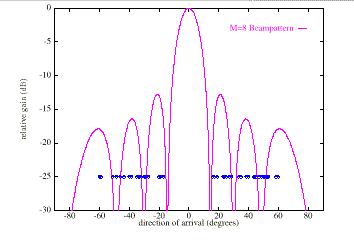 |
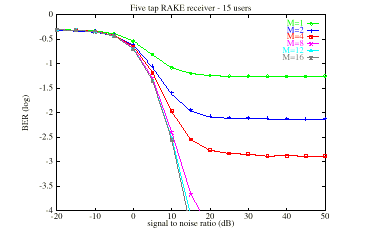
|
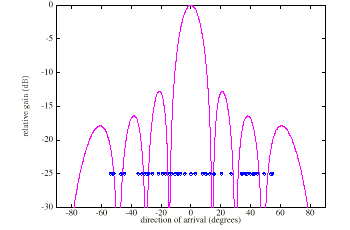 |
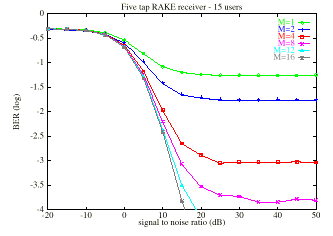
|
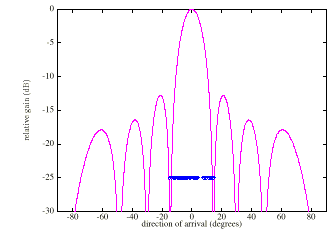 |
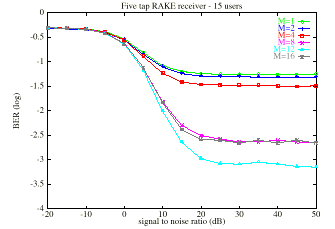
|
A 1 GHz receiving system employing an 8-element 0.5 l spaced array where 50 received data symbols are used to estimate the signal scenario. With this 8-element antenna the array gain is 9 dB and the theoretical output SINR is 14 dB. A 1-D RAKE filter would achieve approximately 11 dB SINR. The results for 0 Hz Doppler after 10,000 averaged simulations show excellent channel estimation performance over a range of angle spreads with the DOA algorithm gradually degrading with spread. The fixed beam performance peaks when the angular spread of the scatterers is well matched to the width of the 8 element beampattern. In comparison at 200 Hz Doppler there is a significant change in the signal scenario over the 50 sample window, degrading particularly the eigenfilter channel estimation which performed so well at the lower Doppler.
It is clear that there is an optimum number of samples to average over, to minimise the combiner losses before the fast fading channel estimates change due to the motion of the mobile terminal.
Summary
The beamspace and bearing estimation (DOA) essentially point narrow beams at the signals from the mobile. This choice is optimal only if each channel tap appears as a point source. If multipath scattering of the signal gives rise to a significant angular width of the signal, the performance will degrade as the M element beamformer has only M - 1 unique beams which are insufficient to handle each of the major signal components. However, the eigenfilter method gives weights that maximise the combiner signal power, so it performs better in the presence of significant angular multipath spread. However, at low SNR, there is little benefit over the bearing estimation techniques. When the signal power of a given tap is not larger than the interference power, the above techniques are likely to incorrectly pick out an interference signal instead of the desired tap vector. However, given that CDMA interference generally comprises the contributions of a large number of smaller power users, it seems unlikely that any technique could correctly pick out a channel estimate with sufficient SINR for the purposes of data decision-making. To overcome this problem, we now require to investigate, in more detail, the operation of blind signal parameter estimation techniques . Convergence of these algorithms is generally fast for small M and high SNR, and it degrades as either of these parameters alters significantly.